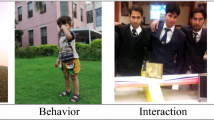Abstract
Recognizing human action is a critical step in many computer vision applications. In this paper, the problem of human behavior classification is addressed from a periodic motion analysis viewpoint. Our approach uses human silhouettes as motion features that can be obtained efficiently, and then projected it into a lower dimensional space where matching is performed. After a periodic analysis, each action unit is represented as a closed loop in this lower dimensional space, and matching is done by computing the distances among these loops. The main contributions are twofold: (1) an efficient periodic action feature constructing method is introduced; and (2) the difference between action units with different phase is computed adaptively with a novel distance proposed in this work. To demonstrate the effectiveness of this approach, human behavior classification experiments were performed on an open dataset. Classification results are highly accurate and show that this approach is promising and efficient.
Similar content being viewed by others
References
Hsieh J W, Hsu Y T, Liao H-Y M. Video-based human movement analysis and its application to surveillance systems. IEEE Transactions on Multimedia, 2008, 10(3): 372–384
Lin W, Sun M T, Poovandran R. Activity recognition using a combination of category components and local models for video surveillance. IEEE Transaction on Circuits and Systems for Video Technology, 2008, 18(8): 1128–1139
Choi J, Cho Y I, Han T. A view-based real-time human action recognition system as an interface for human computer interaction. In: Proceedings of 13th International Conference on Virtual Systems and Multimedia, 112–120
Su C W, Liao H-Y M, Tyan H R. Motion flow-based video retrieval. IEEE Transactions on Multimedia, 2007, 9(6): 1193–1201
Aggarwal J K, Cai Q. Human motion analysis: a review. Computer Vision and Image Understanding, 1999, 73(3): 295–304
Moeslund T, Granum E. A survey of computer vision based human motion capture. Computer Vision and Image Understanding, 2001, 81(3): 231–268
Wang L, Hu W, Tan T. Recent developments in human motion analysis. Pattern Recognition, 2003, 36(3): 585–601
Polana R, Nelson R. Detecting activities. In: Proceedings of Computer Vision and Pattern Recognition, 1993, 2–7
Niyogi S, Adelson E. Analyzing and recognizing walking figures in xyt. In: Proceedings of Computer Vision and Pattern Recognition, 1994, 469–474
Baumberg A, Hogg D. An efficient method for contour tracking using active shape models. In: Proceedings of IEEE Workshop on Motion of Non-Rigid and Articulated Objects, 1994, 194–199
Park S, Aggarwal J K. Recognition of human interaction using multiple features in grayscale images. In: Proceedings of 15th International Conference on Pattern Recognition, 2000, 1: 51–54
Dever J, da VitoriaLobo N, Shah M. Automatic visual recognition of armed robbery. In: Proceedings of IEEE International Conference on Pattern Recognition, 2002, 451–455
Zelnik-Manor L, Irani M. Statistical analysis of dynamic actions. IEEE Transactions on Pattern Recognition and Machine Intelligence, 2006, 28(9): 1530–1535
Wang L, Suter D. Analyzing human movements from silhouettes using manifold learning. In: Proceedings of IEEE International Conference on Video and Signal Based Surveillance, 2006, 7–7
Yacoob Y, Black M J. Parameterized modeling and recognition of activities. Computer Vision Image Understanding, 1999, 73(2): 232–247
Murase H, Sakai R. Moving object recognition in eigenspace representation: gait analysis and lip reading. Pattern Recognition Letter, 1996, 17(2): 155–162
Masoud O, Papanikolopoulos N. A method for human action recognition. Image and Vision Computing, 2003, 21(8): 729–743
Stauffer C, Grimson W. Adaptive background mixture models for real-time tracking. In: Proceedings of the IEEE Computer Society Conference on Computer Vision and Pattern Recognition, 1999, 246–252
Cutler R, Davis L. Robust real-time periodic motion detection, analysis, and applications. IEEE Transactions on Pattern Recognition and Machine Intelligence, 2000, 22(8): 781–796
Rao C, Yilmaz A, Shah M. View-invariant representation and recognition of actions. International Journal of Computer Vision, 2002, 50(2): 203–226
Turk M, Pentland A. Eigenfaces for recognition. Journal of Cognitive Neuroscience, 1991, 13(1): 71–86
Author information
Authors and Affiliations
Corresponding author
Rights and permissions
About this article
Cite this article
Wang, J., Chen, D. & Yang, J. Human behavior classification by analyzing periodic motions. Front. Comput. Sci. China 4, 580–588 (2010). https://doi.org/10.1007/s11704-009-0070-y
Received:
Accepted:
Published:
Issue Date:
DOI: https://doi.org/10.1007/s11704-009-0070-y




